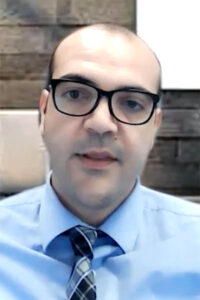
Bronchoscopic procedures to treat COPD continue to evolve. A panel of experts discussed the dynamics of current, novel, and emerging treatments for COPD during the CHEST 2021 session, A Breath of Fresh Air: Bronchoscopic Interventions for Patients With COPD.
Van K. Holden, MD, FCCP, Assistant Professor, University of Maryland School of Medicine, began the session with a discussion of bronchoscopic lung volume reduction (BLVR), including an overview of the procedure, associated complications, and outcomes.
Pneumothorax is the most commonly reported complication of BLVR, occurring in up to 34% of patients and most often within 3 days of treatment. As a result, Dr. Holden said, post-procedure care for patients undergoing BLVR should include hospitalization for at least 3 days and advanced planning for pneumothorax.
“In general, the outcome of pneumothorax after valve placement is resolution with no long-term side effects; however, prolonged air leak is common,” she said.
Most complications, including pneumothorax, occur within 90 days of BLVR, although 8% of patients develop pneumonia within 1 year, Dr. Holden said. Post-procedure follow-up is recommended at 1 to 2 weeks, 1 month, 3 months, 6 months, 12 months, and yearly thereafter.
A meta-analysis of 10 studies showed significant increases in forced expiratory volume (FEV1) and St. George’s Respiratory Questionnaire (SGRQ) scores in patients who had undergone BLVR with either the Zephyr Endobronchial Valve or the Spiration Valve System, but only the Zephyr valves showed significant improvement in 6-minute walk distance, Dr. Holden explained. In patients with heterogeneous emphysema without collateral ventilation, both valves were equally efficacious in FEV1 and SGRQ improvement.

Vivek Murthy, MD, FCCP, Assistant Professor and Associate Director of Interventional Pulmonology, NYU Langone Health, provided an overview of predictors for best outcomes for BLVR.
He listed absolute contraindications for BLVR candidacy, including an active infection or recent episode of bronchitis or pneumonia, active smoking, an allergy to any of the components of an endobronchial valve (silicone, nitinol, polyurethane, and nickel), bullae occupying more than one-third of the hemithorax, and incomplete lobar fissures.
“An ideal patient would be someone who has completed pulmonary rehab and remains very symptomatic despite maximal medical therapy for COPD,” Dr. Murthy said.
Other suggested inclusion criteria include patients with Global Initiative for Chronic Obstructive Lung Disease stage 3-4 or grade C-D, hyperinflation, a reduced 6-minute walk distance, and a Modified Medical Research Council dyspnea score of ≥2.
Computed tomography and single photon emission computed tomography imaging and invasive techniques are used to evaluate patients for BLVR, Dr. Murthy noted.

Christian Ghattas, MD, Assistant Professor of Medicine, The Ohio State University Medical Center, addressed the potential of novel bronchoscopic therapies for COPD.
Targeted lung denervation is a potentially minimally invasive method of denervating the lungs of pulmonary vagal inputs, Dr. Ghattas explained. This approach targets the peribronchial branches of the vagus nerve while preserving the bronchial epithelium and aims to achieve sustained bronchodilation and reduced mucus secretion, simulating the effect of anticholinergic drugs.
Preclinical human trials have demonstrated the feasibility of targeted lung denervation, he noted.
Other emerging treatments include bronchial rheoplasty and metered cryospray.
“Bronchoscopic therapies for patients with chronic bronchitis are still in the early phase of clinical research, and larger randomized controlled trials are ongoing to confirm the available data and to evaluate the treatment durability,” Dr. Ghattas said.
ACCESS SESSIONS ON DEMAND
Registered CHEST 2021 attendees have continued access to 200+ educational sessions until October 1, 2022. Watch sessions on your own schedule and earn up to 50 CME credits/MOC points.
Don’t forget to claim your credit! The deadline is December 15, 2022, at 11:59 pm CT.



